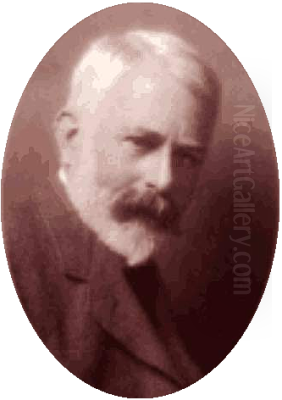
Archibald Thorburn stands as one of the most celebrated and influential wildlife artists Britain has ever produced. Flourishing during the late nineteenth and early twentieth centuries, his name became synonymous with exquisitely detailed and lifelike portrayals of birds, rendered primarily in watercolour. His work captured the imagination of the public and served as invaluable resources for ornithologists, setting a standard for natural history illustration that remains admired today. Born in Scotland but achieving fame across Britain, Thorburn's dedication to his craft and his deep understanding of the natural world cemented his legacy as a master of avian art.
Early Life and Formative Years
Archibald Thorburn was born in 1860 in Lasswade, Midlothian, near Edinburgh, Scotland. He was the fifth son of Robert Thorburn (1818-1885), himself a highly respected artist. Robert Thorburn was renowned as one of the leading portrait miniaturists of his time, enjoying royal patronage and notably painting portrait miniatures for Queen Victoria. This artistic household undoubtedly provided young Archibald with an early immersion in the world of art and a foundation upon which to build his own talents.
His initial education took place in Dalkeith and Edinburgh. The rich natural landscapes of Scotland likely played a significant role in fostering his early interest in wildlife. Following the death of his father, Thorburn sought to further his artistic training and moved south to London. This relocation marked a pivotal step in his journey towards becoming a professional artist, placing him closer to the heart of the British art world and its institutions.
Thorburn enrolled at the St John's Wood School of Art in London. While this institution provided formal art training opportunities, sources suggest his time there was relatively brief. It appears he did not pursue an extensive period of formal academic training within its walls, perhaps finding his true artistic direction lay more in specialized mentorship and direct observation of nature. His innate talent and the foundational skills likely acquired under his father's guidance were already significant.
Mentorship and Key Influences
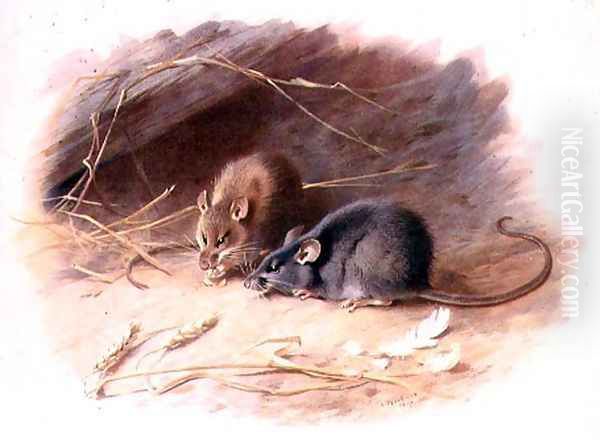
A crucial figure in Thorburn's artistic development was Joseph Wolf (1820-1899). Wolf, a German-born artist who had settled in London, was widely regarded as the finest all-around animal painter of his generation, particularly excelling in natural history illustration. Thorburn sought guidance from Wolf, and this mentorship proved highly influential, particularly in honing the scientific accuracy and anatomical understanding necessary for wildlife art. Wolf's own meticulous approach and ability to capture the spirit of his subjects undoubtedly resonated with the aspiring Thorburn.
Thorburn's work emerged within a rich tradition of wildlife and animal art. While developing his unique style, he would have been aware of the towering achievements of figures like John James Audubon (1785-1851), whose dramatic compositions in The Birds of America set a benchmark for ornithological art, albeit with a distinctively American flair. In Britain, the legacy of artists like John Gould (1804-1881), a prolific publisher and illustrator who employed artists like Joseph Smit (1836-1929) and indeed Joseph Wolf, created a vibrant scene for natural history illustration.
The whimsical yet accurate bird drawings of Edward Lear (1812-1888), better known for his nonsense verse, also formed part of the artistic landscape. Thorburn's dedication to capturing animals in their natural settings finds parallels, though with stylistic differences, in the work of contemporaries across Europe, such as the Swedish master Bruno Liljefors (1860-1939), known for his dynamic portrayals of wildlife in action. Thorburn's father, Robert Thorburn, though a portraitist, provided the initial artistic grounding.
Development of an Unmistakable Style
Archibald Thorburn's artistic reputation rests firmly on his mastery of the watercolour medium. He possessed an exceptional ability to manipulate pigments and water to render the subtle textures of feathers, the glint in an eye, and the soft fur of mammals with remarkable precision. His technique allowed for both fine detail and a sense of light and atmosphere, bringing his subjects to life on the page.
His primary subjects were birds, depicted with an accuracy that satisfied ornithologists, yet imbued with a vitality that appealed to art lovers. He also painted mammals, often showcasing them with the same careful attention to detail and context. A defining characteristic of Thorburn's work is the placement of his subjects within meticulously rendered natural habitats. These were not mere backdrops but integral parts of the composition, showing the interconnectedness of species and environment, often depicting harmonious landscapes.
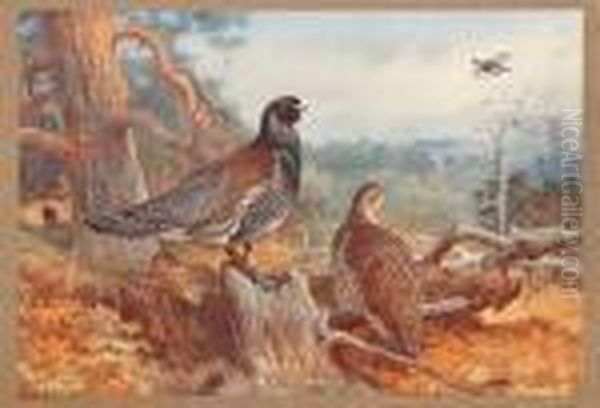
Thorburn's style is characterized by its scientific accuracy combined with artistic sensitivity. He was a keen observer, spending considerable time sketching outdoors, directly from life. His visits to places like the Gaick Forest in Invernesshire provided invaluable opportunities to study birds and animals in their natural surroundings, capturing their characteristic poses and behaviours. This commitment to fieldwork lent an authenticity to his work that set it apart. While detailed, his work avoided the stiffness of purely diagrammatic scientific illustration, possessing instead a painterly quality and often a sense of drama or narrative. This approach differed from the charming, anthropomorphized yet still detailed animal illustrations of someone like Beatrix Potter (1866-1943).
A Prolific Illustrator: Major Published Works
Thorburn's talent quickly gained recognition, leading to numerous commissions for book illustrations, which became a cornerstone of his career. One of his earliest significant projects was providing coloured illustrations for W.F. Swaysland's Familiar Wild Birds, published in 1883. This work helped establish his reputation for depicting British birds accurately and attractively.
His most monumental illustrative achievement was arguably the commission from Lord Lilford (Thomas Powys, 4th Baron Lilford), a prominent ornithologist and founder of the British Ornithologists' Union. Thorburn painted an astonishing 268 watercolours for Lilford's Coloured Figures of the Birds of the British Islands (1885-1897). This extensive series is considered a landmark in British ornithological illustration, showcasing Thorburn's ability to consistently produce high-quality, detailed work across a vast range of species.
Thorburn also contributed significantly to other major ornithological publications. He provided illustrations for works such as A History of the Birds of Europe, a comprehensive work primarily associated with Henry Eeles Dresser (1838-1915), and the Ornithology of the Straits of Gibraltar. His involvement in these prestigious projects solidified his position as the go-to artist for accurate and aesthetically pleasing bird illustrations.
Beyond illustrating the works of others, Thorburn also authored and illustrated his own books. A Naturalist's Sketchbook, published around 1890 (though some sources suggest later dates for expanded versions), showcased his skill across a broader range of wildlife, including mammals, and offered insights into his observational process. Later in his career, he produced British Mammals (1920-1921), featuring plates such as the meticulously rendered 'Black Rat' (Mus rattus) and 'Harvest Mouse' (Mus minutus).
He continued to contribute to significant publications throughout his career. He provided illustrations for British Diving Ducks by John Guille Millais (1865-1931), himself a notable wildlife artist and naturalist, and son of the Pre-Raphaelite painter John Everett Millais. Thorburn's own Game Birds and Wild Fowl of Great Britain and Ireland (1927) stands as another important late-career work, demonstrating his enduring skill and focus on specific groups of birds often associated with sporting interests. The sheer volume and consistent quality of his illustrative output had a profound impact on the study and appreciation of British wildlife.
Exhibition History and Professional Recognition

In the earlier part of his career, Archibald Thorburn sought recognition through established art institutions. He exhibited numerous works at the prestigious Royal Academy of Arts in London between 1880 and 1900. Having works accepted and displayed at the Royal Academy was a significant mark of achievement for artists during this period. His submissions likely focused on his detailed watercolours of birds and wildlife.
However, Thorburn reportedly grew disillusioned with the Royal Academy. One anecdote suggests his frustration stemmed from the way his intricately detailed works were hung – often placed too high on the gallery walls ('skyed'), making it difficult for viewers to appreciate the fine workmanship. This dissatisfaction led him to seek alternative venues for showcasing his art more effectively.
From the late 1890s onwards, Thorburn began exhibiting his work primarily at the A Baird Carter Gallery in Jermyn Street, London. This move allowed him greater control over how his paintings were presented and likely provided a more intimate setting for viewers to engage with his detailed watercolours. He also exhibited at other venues, including the New Bond Street Gallery and various private galleries, indicating a strong demand for his work outside the confines of the Academy.
Beyond the art world, Thorburn gained recognition for his contributions to conservation. He held the esteemed position of Vice-President of the Royal Society for the Protection of Birds (RSPB). In a charming intersection of his art and conservation work, he designed the very first RSPB Christmas card in 1899, featuring sketches of robins. This role highlights his commitment to wildlife preservation, a commitment perhaps deepened by personal experiences.
The enduring appeal and value of Thorburn's work are evident in the art market. His original watercolours and paintings continue to be highly sought after by collectors. Auction houses like Sotheby's regularly feature his works, often achieving significant prices. For instance, a watercolour depicting Black Grouse reportedly sold for £8,300 in 2019. Furthermore, limited edition prints of his popular images, such as 'Winter Black Grouse', were produced, making his art accessible to a wider audience and demonstrating its lasting commercial viability.
The Naturalist Behind the Artist
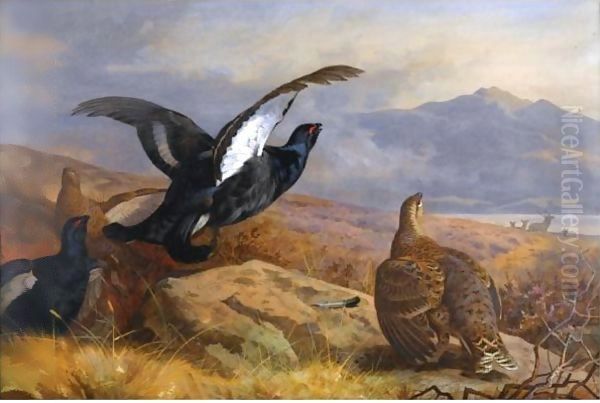
Archibald Thorburn was more than just a painter of animals; he was a dedicated naturalist. His profound understanding of his subjects stemmed from countless hours spent in the field, observing wildlife firsthand. His frequent sketching trips, particularly to the Scottish Highlands like the Gaick Forest, were essential to his process. He didn't just paint birds; he studied their posture, flight patterns, interactions, and preferred environments, infusing his artwork with authenticity.
Interestingly, Thorburn's deep connection with nature evolved over time. In his earlier years, like many gentlemen of his era, he was involved in shooting sports. He participated in hunts, including at notable locations like Sandringham, the royal estate. This activity, while perhaps ethically complex by modern standards, undoubtedly provided him with close access to game birds and other wildlife, contributing to his anatomical knowledge and understanding of animals in motion.
A significant turning point reportedly occurred during one such outing. The story goes that Thorburn accidentally shot a hare. The sound of the injured animal's cry deeply affected him, leading him to renounce hunting altogether. This profound experience is often cited as a catalyst for his increased focus on conservation and the sympathetic portrayal of animals in his art. Whether apocryphal or entirely factual, this narrative reflects a shift towards preservationist values that aligned with his later role in the RSPB.
His move later in life to Hascombe in Surrey, a place surrounded by nature, further underscores his lifelong affinity for the natural world. He created a garden designed to attract birds, allowing him to continue his observations close to home. This dedication to direct observation remained central to his artistic practice throughout his life, distinguishing him as an artist deeply rooted in the study of natural history.
Contextualizing Thorburn: Contemporaries and Comparisons
Archibald Thorburn's career unfolded during a golden age of natural history illustration and wildlife art in Britain. His work stands alongside, yet is distinct from, that of several talented contemporaries. We've already noted his mentorship under Joseph Wolf and his collaborations with John Guille Millais. Both were significant figures, with Millais also known for his large-scale oil paintings of wildlife and landscapes.
Other notable British bird artists active during Thorburn's time included George Edward Lodge (1860-1954). Lodge, born in the same year as Thorburn, was also highly respected for his paintings of birds, particularly birds of prey, often working in oils as well as watercolour. His style, while accurate, perhaps had a broader, more atmospheric feel compared to Thorburn's meticulous detail.
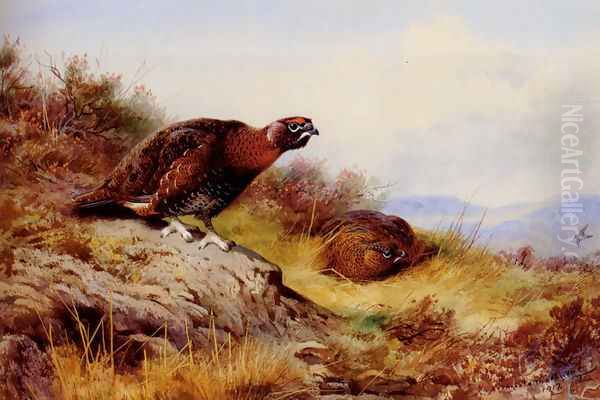
Charles Whymper (1853-1941) was another contemporary known for his wildlife illustrations and paintings, often featured in books on sport and natural history. His work, too, contributed to the rich visual culture surrounding British wildlife. Additionally, Henrik Grönvold (1858-1940), a Danish-born artist who spent most of his career in London working for the Natural History Museum and illustrating scientific publications, represented the more strictly scientific end of the spectrum, though his work was also highly skilled.
Comparing Thorburn to these artists highlights his particular niche. While sharing a commitment to accuracy with figures like Grönvold, Thorburn's work possessed a greater painterly quality and compositional artistry, often exceeding the requirements of pure scientific illustration. Compared to Lodge or Millais, who also worked in oils, Thorburn's primary dedication to watercolour allowed him to achieve a unique luminosity and fineness of detail, particularly in rendering feathers. His ability to place birds convincingly within detailed, evocative landscapes became a hallmark that distinguished his prolific output.
Later Life and Enduring Legacy
In his later years, Archibald Thorburn settled in Hascombe, near Godalming in Surrey. He purchased a house called 'High Leybourne' (later renamed) in 1902 and lived there for the rest of his life. The surrounding countryside provided continued inspiration and subjects for his art. He designed his garden specifically to attract birds, ensuring a constant source of models and observation opportunities right outside his window. He continued to paint and illustrate, although the sheer volume of his output may have lessened compared to his peak years.
Sources suggest that, like many individuals reaching advanced age, Thorburn may have experienced declining health and energy in his final years. Nevertheless, he remained a revered figure in the world of wildlife art. His dedication to his craft never wavered, and he continued working until shortly before his death. Archibald Thorburn passed away in Hascombe on October 9, 1935, at the age of 75.
His legacy is immense and multifaceted. As an artist, he is remembered for his technical brilliance in watercolour, his unparalleled ability to capture the beauty and detail of birds, and his skill in creating compositions that were both scientifically accurate and aesthetically pleasing. His work set a standard for ornithological illustration that influenced generations of wildlife artists who followed. Many consider the period of his major book illustrations to represent a high point in British bird art.
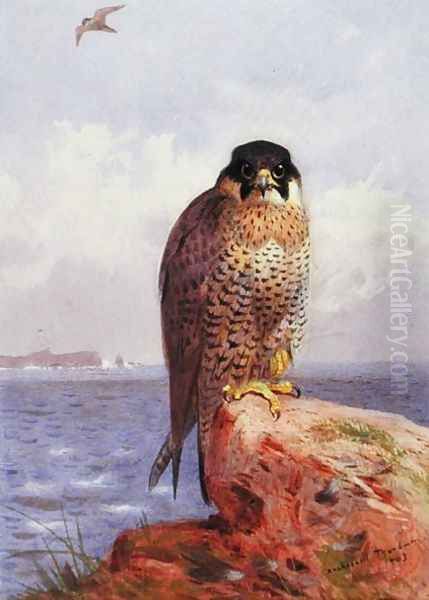
Beyond his artistic contributions, Thorburn played a role in the burgeoning conservation movement through his work with the RSPB. His art helped foster a greater appreciation for Britain's natural heritage, potentially encouraging public interest in bird protection. His paintings and illustrations remain highly valued not only as works of art but also as historical documents, capturing the appearance and behaviour of wildlife at the turn of the twentieth century. Today, his original works are prized collector's items, and reproductions continue to be popular, ensuring his vision of the natural world remains accessible.
Conclusion
Archibald Thorburn remains an undisputed giant in the field of British wildlife art. His life's work represents a remarkable fusion of artistic talent, meticulous observation, and a deep love for the natural world. As a master watercolourist, he brought birds and mammals to life with unparalleled detail and sensitivity. Through his extensive contributions to ornithological literature, he not only documented Britain's fauna but also elevated the standard of natural history illustration. His journey from sportsman to conservation advocate adds another layer to his story. Decades after his death, Thorburn's paintings continue to captivate viewers, serving as beautiful reminders of the intricacies of nature and the enduring power of skilled artistic representation. His historical position as Britain's premier bird painter of his era is secure, his influence still felt today.